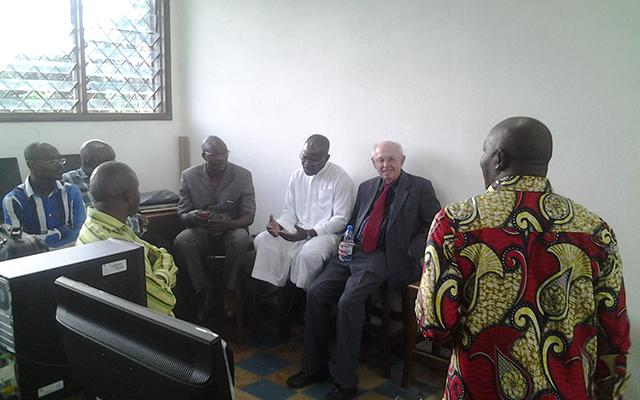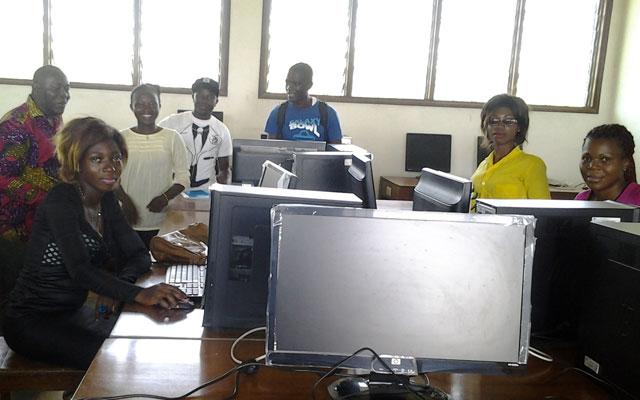Single cells in a tissue are like the first violin in an orchestra: they play solo, but they also deal with the ensemble. And, as it happens with the instruments in the orchestra, if one cell falls out of tune with the others, the whole tissue may suffer.
Understanding the role of single nerve cells – and of the orchestra they play within – is at the core of Alain Moise Dikande's research. Dikande is a theoretical physicist from the University of Buea (UB), in Cameroon, and the recipient of a TWAS research grant in basic sciences.
Dikande is the head of the department of physics and a group leader in UB's laboratory of research on advanced materials and nonlinear sciences. Applying new knowledge to health problems that affect Cameroon is the ultimate goal for his research team.
"Nerve-related diseases are quite common in Cameroon and are of various origins, including social and environmental sources," he explains. "The economic situation of the country, the socio-cultural conflict of generations and the weight of local traditions on life of individuals – combined with others such as the climate and the inadequate health care system – are among the main factors that maintain people in a quasi-permanent state of stress" and open the door to nerve-related disorders.
Dikande is also an associate professor in physics and a fellow of the Alexander von Humboldt Foundation in the “experienced research” category. He holds a doctorate in nonlinear physics from Cameroon's University of Yaoundé I, and a PhD in condensed matter physics from the University of Sherbrooke, Canada in 2004. However, he experienced a turning point in his career in 1995, during his first visit at the Abdus Salam International Centre for Theoretical Physics (ICTP), in Trieste, Italy. At that time he had the opportunity to attend a course on structure and function of biological systems, which changed the course of his investigations, and possibly of his entire life.
"During that workshop in Trieste I realized the tremendous potential and impact of an emerging discipline called systems biology, which lies at the interface between physics and biology," recalls Dikande. "There I decided that I wanted to start investigating the relationship between the function one nerve cell is devised for and its chemical activity, both in their normal and pathological states." So he decided to focus on single nerve cells and subsequently on the behaviour of the nervous tissue.
Systems biology gained momentum at the onset of the new millennium, triggering a "system thinking" approach to biological problems. This discipline aims at systematic investigation of complex new properties and behaviours that emerge from the interaction of single cells (or, in general, from biological components) when they are considered together instead of individually.
When they work as a unique body, cells usually exhibit properties that are hard to predict in an individual cell. And these new characteristics require complex algorithms and computer simulations to study and to describe.
That's where a TWAS grant was able to support the work of his team. TWAS awards individual researchers as well as groups through its research grants programme, which selects promising high-level projects in biology, chemistry, mathematics and physics. The programme is currently funded by the Swedish International Development Cooperation Agency (Sida), the Italian government and COMSTECH in Pakistan. With an average USD1.7 million per year, TWAS distributed more than 2,200 grants between 1986 and 2013.
The grant to Dikande allowed him to buy equipment and laboratory materials for his investigations, like a new server, eight desktop PCs, one printer and a number of accessories. The project started effectively February 2013, but it took Dikande some time to receive and install the equipment before the team could begin.
Dikande's group includes four senior PhD holders, ten PhD students and 16 masters of science students. He also supervises research projects of students in the African Institute for Mathematical Sciences (AIMS-Cameroon), and has ongoing collaborations on this subject with several cooperating institutions.
Cameroon has 99 private institutes of higher education and 700 laboratories. The nation's Ministry of of Scientific Research & Innovation (MINRESI), for example, works in close partnership with other institutions including eight state universities and seven private universities, as well as with partner research organizations and non-governmental organizations. Hence it is no surprise that the Task Force 10 on Science, Technology and Innovation, commissioned by UN Secretary General Ban Ki-moon, ranked Cameroon in the class of scientifically developing countries instead of scientifically lagging countries.
The first, and perhaps more important, goal of his investigation is still defining what is the normal state for a nerve cell – that is, the conditions whereby the cell operates optimally and in a fault-free mode. "To understand pathologies and unveil why nerves fail to function normally, we need to understand this idealized normal state," says Dikande. This, in turn, would allow the identification of abnormal, pathological states where neurons are disconnected from each other or from the brain, which is the central processing organ.
In the very early phases of his project, Dikande took the first steps from a biophysical model already well-accepted – called the Hodgkin-Huxley model – that describes the behaviour of a nerve cell, to see if such model could be implemented or refined.
How do nerve cells work? As Dikande explains: "In response to external stimuli, cells allow specific ions (calcium, potassium and sodium) to move across their membrane. This event creates an electric current, called action potential, which generates a new cascade of events, triggering a final action." This is how the cell responds to that specific stimulus. And he adds: "The Hodgkin-Huxley picture gives a prominent role to the ion exchange across the membrane. But this is not the whole picture." Another, more recent model (called the soliton model) suggests that more chemical elements should be taken into consideration.
"These two 'schools' with conflicting understandings of how chemical activity of the nerve cells generates the action potential call for further investigations," he said. "This is precisely where we want to give our contribution."
Once they elucidate the functioning of single healthy nerve cells, Dikande and colleagues will concentrate on describing abnormal, chaotic situations in complex nervous tissues. Computer simulations – algorithms and large-scale numerical simulations – are the tools they use to produce theoretical new frames that describe how the nervous system works in normal and disordered conditions. Then the team will merge this information with experimental data obtained also from biophysical and biological lab experiments.
Dikande estimates that the benefit of this project to his country and to the local institutions could be significant. "Cameroon is a scientifically growing country," he observes, "and this project is the very first of its kind."
"If we come up with a consistent model for the nerve functioning, we will be able to detect and evaluate the level of damage and malfunctioning of the nerve, understand how nerve cells are regenerated and use such an insight to think of nerve-repair techniques, design pace-makers (artificial nerves) and more. In Cameroon there is a great demand for local expertise to address this issue affecting the population’s productivity."
Cristina Serra



